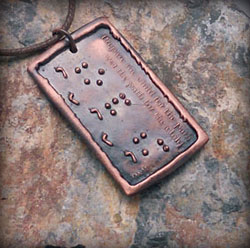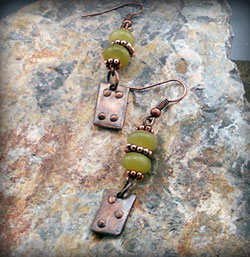Seeing the Future: Copper Braille Jewelry
 Copper pendant with braille lettering.
Copper pendant with braille lettering.Photograph courtesy of Kelly Fehr
Growing up, the creative nature of her mother and grandmother left a lasting impression on copper artist, Kelly Fehr.
"I learned from them how to fix things, problem-solve and be a creative person," she says. By high school she knew she wanted to become a professional artist and in college she fell in love with metals like copper and silver, jewelry-making and design. Eschewing larger work for small, she began to craft pendants, bracelets and earrings. She took a job at Lenox, the tablewear company, but her first passion was always jewelry.
"You may have a sculpture in your yard, but jewelry is so much more personal," she says. "It's your own portable sculpture."
Although she loved copper and bronze, the costs for the metals were high, so she opted instead for metal clays. "It gave me minimal investment in tools and supplies, and a huge opportunity for shape-form design and learning a new material. The bronze clay rocked my world."
Copper and bronze clays have a similar consistency to Play-Doh Fehr says. Clay is mixed with pure copper or bronze powder. After a jewelry piece is crafted and finished, it's kiln fired at 1,600 degrees for three hours and during that process the copper powder melds together, forming a solid piece amounting to a copper density of 95 percent. The powdered copper is held together with an organic binder which burns away allowing the metal to form. Fehr then uses liver of sulfur to oxidize the copper, polishing the pieces with an abrasive brush to highlight the copper and bronze accents.
 Braille Copper earrings.
Braille Copper earrings. Photograph courtesy of Kelly Fehr
"The dark copper finish to me is the richest of the finishes, visually it's the most stimulating," she says. And the bronze and copper clays have become her signature aesthetic. "My personal favorite is the patina copper because it's a warm, rich and beautiful look."
But things took a turn when her niece, Emily, born blind, prodded her to create something unique for her, so Fehr began making jewelry with braille. She uses a syringe to make the Braille dots on top of the copper pendent, "almost like a cake decorator," she says. "Just because someone is blind or visually impaired, doesn't mean they don't appreciate nice things," she says. "The people who are buying my pieces respond to the same level of sophistication and design."
Today, the idea of the Braille pendants has taken off. She has produced high volume pieces for stores as well as individual pieces for clients and the public. She has sold her work in all 50 states as well as Switzerland, Canada and Japan. She even created 300 special pieces for a blind theatre group in Los Angeles as a fundraiser. She's still surprised about this path which has taken her in a direction she wouldn't have dreamed of.
"I found a niche that's extremely satisfying," she admits about her Braille jewelry. "A blind person wearing my copper jewelry in the sighted world makes it something for everyone to share and experience."
Resources:
Also in this Issue:
- The Mica Lamp Company: Beautiful Lighting Inspired by Turn-of-the-Century Craftsmanship
- Warfare Crafted Into Works of Art
- Seeing the Future: Copper Braille Jewelry
- 2-Roses Studio: A Lifelong Journey of Exploration and Experimentation
- Rare Rembrandt Self-Portrait Rediscovered
